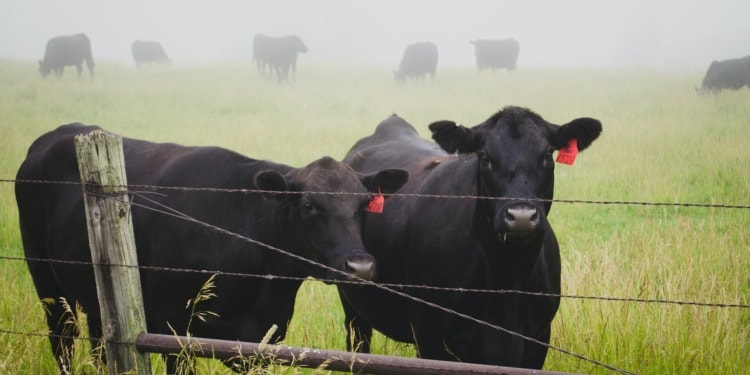Veganism has long been lauded as not only a healthier diet for your body, but also as a plant-based lifestyle that’s better for our planet. It’s also growing in popularity, with 2% of the UK’s population now following a vegan lifestyle. Germany is thought to have the largest population of people turning away from meat and animal products in Europe, with 3% of the population describing their diet as vegan.
A vegan diet, as well as not consisting of meat from any animal, also does not consist of other food derived from animal products such as dairy milk, eggs and honey. Unlike vegetarianism, the vegan lifestyle also extends itself to other parts of everyday life. Some clothing materials such as real leather and snakeskin are not vegan, pharmaceuticals that have been tested on animals are not vegan, nor is the use of animals for entertainment purposes, such as horseracing for sport.
Evidence shows that the meat and dairy industry, along with rice farming, is the biggest source of emissions in the food system, perhaps even driving the world past its 1.5℃ warming limit.
What’s more, scientists advise that cutting down on meat consumption – as well as changing production and reducing waste – could help cut warming rates by 55%.
“If you’re serious about protecting the environment, the most important thing that you can do is stop eating meat, eggs, and dairy ‘products,'” People for the Ethical Treatment of Animals (PETA) argues.
But are there any negative impacts associated with some popular plant-based alternatives as well? Evidence is now mounting that suggests some vegan alternatives are not completely unproblematic when it comes to impact on the environment.
The vegan quandary
A key argument in support of the vegan diet is that 80% of Amazon rainforest deforestation is the result of felling for cattle ranches, releasing large quantities of carbon into the atmosphere and deeply affecting biodiversity.

However, the farming of soya, a staple ingredient in many vegan diets, has also led to the destruction of rainforests. According to the WWF, a land area of over 280 million acres – the size of France, Germany, and the United Kingdom combined – was cleared for soya bean production in 2013-2014. Most of this is driven by animal feed in the meat and dairy industry but nearly a fifth is used directly for human consumption.
As the vegan diet becomes more popular, the demand for crops like soya, maize and grains will increase. According to a study conducted by BioMed Central, these crops respond significantly better to more fertiliser when crop yield is measured. Fertilisers can have a devastating impact on ecosystems, polluting water and emitting odours and gases into the atmosphere.
Milk alternatives, made from high-in-demand crops like almond, oat and soya, have also been found to have some associated negative impacts. Almond growers douse their crops in glyphosate, a herbicide that kills bees in staggering numbers. Glyphosate, a substance known to cause cancer in humans, was found along with other pesticide residues to be present in 94% of oats, according to the Pesticide Action Network UK.
What’s more, protein alternatives in vegan diets often have to be imported. Beans from Brazil, pulses from India and lentils from Canada all have to be transported – the transportation of food alone accounts for almost 20% of total emissions from food systems.
Related articles: Global Report on Food Crises: Number of People Facing Acute Food Insecurity Rose to 258 Million in 2022, Is a Vegan Diet Safe For Children?, Seed Protein: A Win-Win for the Environment and Your Health?, How to Start Eating a More Sustainable Diet.
Vegetables common in the vegan palette such as avocados also need to be imported from Mexico and California
Water use is another issue more complicated than it looks. The meat and dairy industry infamously consume a lot of water, according to the United States Geological Survey it takes over 8,300 litres of water to produce one pound of beef and over 1,800 for a pound of chicken.
Vegan dietary staples, however, are not miracle alternatives. A single mature avocado tree growing in California, an area already facing water scarcity issues, requires as much as 209 litres of water everyday in warm periods. Almonds also need a lot of water, with 12 litres required to produce just one nut.
Balance is the best solution
Whilst veganism does cut down significantly on carbon emissions and resource use, it is not exempt from the environmental concerns that come along with specific dietary choices.
There are a huge variety of ways to reduce carbon emissions through food. For some people, it may simply be that a flexitarian diet – a reduction in the amount of animal products consumed – is better than consuming large amounts of nuts or avocados that have their own environmental repercussions.
Veganism is the best dietary solution when it comes to helping the climate crisis, but only when your food, as with all diets, is responsibly sourced. It is also important to remember that animal products are still important for supplying nutrients.
In addition to encouraging veganism and promoting its environmental positives, it might also be time to re-evaluate how we produce our food, transport, cook and dispose of it.
Editor’s Note: The opinions expressed here by the authors are their own, not those of Impakter.com — In the Featured Photo: Cattle grazing. Featured Photo Credit: Unsplash.













